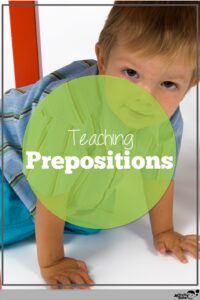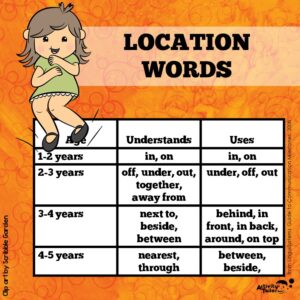
Prepositions are little words with an important responsibility. These are what we use to indicate the location or position of things. They’re words like “in,” “under,” “behind” and “next to.”
Some of these develop early, during the toddler years, like “in” and “on.” Others will still be tricky up until our kids enter school; words like “through” and “between.”
Because understanding a preposition means understanding the position of one thing in relation to another, I find it particularly helpful to teach these words by moving around, and, to start, I have the child move their own body into different relative positions.
This is what it looks like.
- Using a laundry basket or large box that a child can get “in” and “out” of.
- Stepping “on” and “off” a low stool or bottom stair.
- Hiding “under” the bed and sitting “on” the bed.
When I start, I typically choose an opposite pair of words (in/on, on/off) or contrast a word I know they’ve mastered with the new one (on/under). I’m very repetitive! At home, you can start emphasizing the position by continually pointing it out.
- “Your lovey is on the bed.”
- “Snack is on the table.”
- “Daddy put a hat on his head.”
- “Let’s put bubbles in the tub.”
- “I’m putting laundry in the washer.”
- “The blocks go in the basket.”
Children will understand a concept before they use it themselves. You can “test” their comprehension by giving them directions with the new preposition.
- “Put your shoes under the bench.”
- “Your car is in your backpack.”
- “Set it on mommy’s chair.”
Curious to see if they can use it in a sentence? Play treasure/scavenger hunt!
Hide an object in the room, but then walk out. Have them find you and tell you where it was! (Or hide the object in a visible place they can’t reach so they have to tell you where to get it from.)
As they develop more understanding and have had real-world practice, I’ll begin pointing out position relationships in pictures too.
- “Oh, look! He’s hiding in the closet!”
- “The excavator is loading rocks in the dump truck.”
- They parked the car next to the playground.”
Once they have these concepts in action, they’re ready to try a visual task. Preposition Readers give them opportunities for “perfect practice.”
Most preschool children I work with have a goal involving prepositions. Let me know which one(s) you’re working on in the comments below!
Looking for more ways to target speech and language goals with play? Join me for Putting Play to Work, a two hour seminar with lots of practical ideas!






